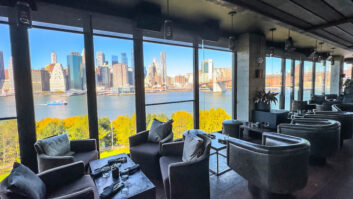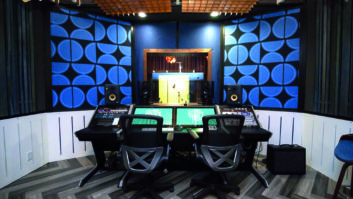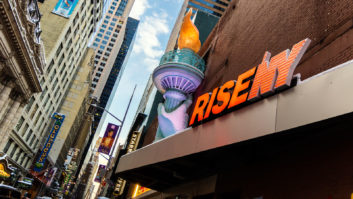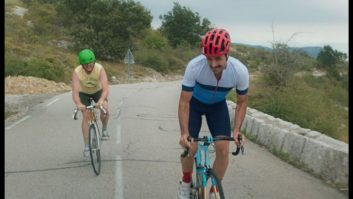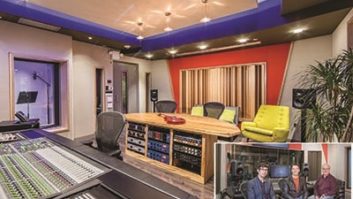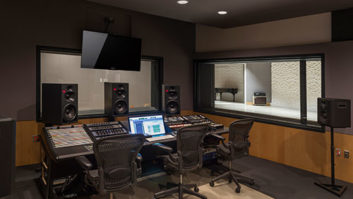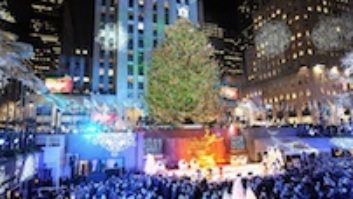Brian Hardgroove took over the Log Cabin to revitalize its business model and client base. First order of business: renaming it The Fuse Box.Manhattan Center is a massive, NYC-based production and entertainment complex that has been active since the early 20th century. Since the 1990s, it has been home to two professional recording studios: Studio 4, commonly referred to by those who have worked there as “The Log Cabin,” and “Studio 7,” which connects into the Grand Ballroom so it can accommodate large-scale projects such as orchestral recordings and film scores. Manhattan Center is home to post-production facilities, two television studios, and one of NYC’s greatest performance halls: the Hammerstein Ballroom. Back in 1926, the facility’s Grand Ballroom was the site for the original orchestral score of Don Juan.

In recent times, the complex continues to thrive and reinvent itself as market dynamics and production values evolve. Studio 4, which is not surprisingly situated on the fourth floor of the complex directly atop the Hammerstein Ballroom, has an interesting history of its own, and has recalibrated itself to remain in synch with an ever-changing recording industry.
Following the untimely death of Hyo Jin Moon, who was involved in running Manhattan Center until 2008, Brian Hardgroove—best known as a guitarist and member of the band Public Enemy— was asked to take over the “Log Cabin” and revitalize its business model and client base. Indeed, the facility had an illustrious history of its own. In fact, a younger Hardgroove actually worked there as an assistant alongside clients like Slash, Supertramp, even Timbaland. Hardgroove was well familiar with the Manhattan Center, and more importantly, had a vision for where he could take the Studio 4 in the future.
Hardgroove wasted no time in rebranding it “The Fuse Box” after his syndicated radio show of the same name. His radio show, which had featured artists like Stewart Copeland, Chuck D, Adrian Belew, Bootsy Collins, and others, reads like a “who’s who” of recording artists, reflecting just about every conceivable genre and background of music. As a member of Public Enemy, Hardgroove had also been a key participant in many of his own recording projects and world tours. Manhattan Center invited him to use this experience—and diverse network of contacts—to pave a new road for the studio’s future.
Hardgroove recalls his initial thoughts at the time of being handed over the reins: “The general plan was to make the studio a hip place to match the image of the ballroom that it sits on top of. Given the contractions of commercial studios in the recent past, I wanted to bring The Fuse Box beyond the traditional rental model. It needed to become a place where we could serve both up-and-coming artists as well as more established acts. We wanted the ability to service clients across the entire financial strata.”
For Hardgroove, most of the foundational elements were already in place to help achieve his goals; he had a greatsounding room, a tried-and-true Neve VR 72-channel console, and most of all, the full support of a massive studio complex. To help take The Fuse Box to the finish line, Hardgroove partnered with some known audio brands: “The room was in good health, and Sennheiser came in and really put the finishing touches on,” he recalls. To ensure the gear reflected the overall image Hardgroove wanted to convey, he also worked with Neumann, Gibson, TC Electronics and Cakewalk, among others.
Joel Scheuneman, chief technical engineer, makes sure that The Fuse Box’s technical infrastructure is ready no matter who is coming in. Aside from the 72-channel Neve VR desk, the facility has an array of monitoring options including large-format Tannoy 215s and pairs of Genelec 8040s and vintage Yamaha NS 10Ms nearfields. Artists working at The Fuse Box can choose to record direct to the Pro Tools HD3 | Accel system, or to its two Studer A27 2-inch, 24-track decks. For outboard, The Fuse Box boasts an array of vintage gear that includes Neve 33609s, Universal Audio 1176 blackface limiters and LA2A compressors, Lexicon PCM 42 delays, and many others.
Among the more notable pieces in the rack is a homemade piece of gear built by Scheuneman himself: a 2-channel Origin Point compressor. Chief audio engineer Darren Moore uses the Origin Point while mixing: “I like it across the mix bus because it has a very smooth, honest compression that doesn’t overstep. It helps me get a hot signal that is not just ‘pumpy’ or distorted.”
Not surprisingly, given its recent partnership, The Fuse Box’s microphone arsenal is built largely around Sennheiser and Neumann. Recent acquisitions include pairs of Sennheiser’s MKH 800 and the MKH 800 twin, and pairs of the MKH 8020 and 8040s. These mics, and others, are not only used in The Fuse Box, but also in many other projects throughout The Manhattan Center facility, including on film scores. To get the guitar tones he is looking for, Moore often relies on a trio of Sennheiser mics on guitar amps: the e 609, the MD 421 and the MD 441.
While gear is a critical link in the results Hardgroove wants to achieve, he recognizes that it is a means to an end: “I am an artist first, not a studio owner first. I am not a gearhead, but I am the captain of the ship. The guys know how to give me more power when I ask for it.”
Manhattan Center Studios/ The Fuse Box
mcstudios.com
